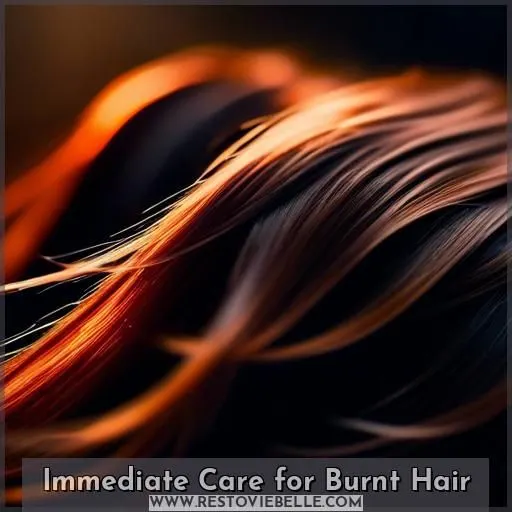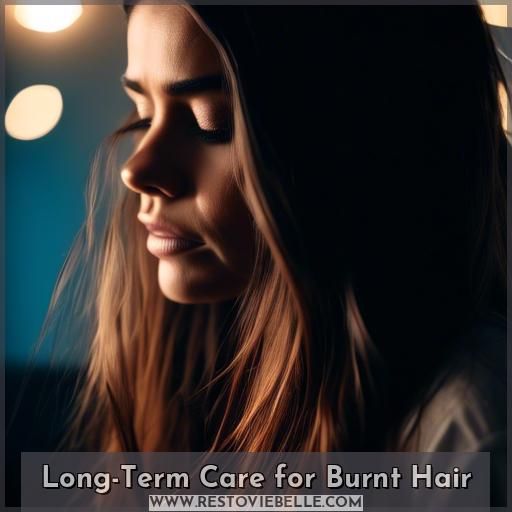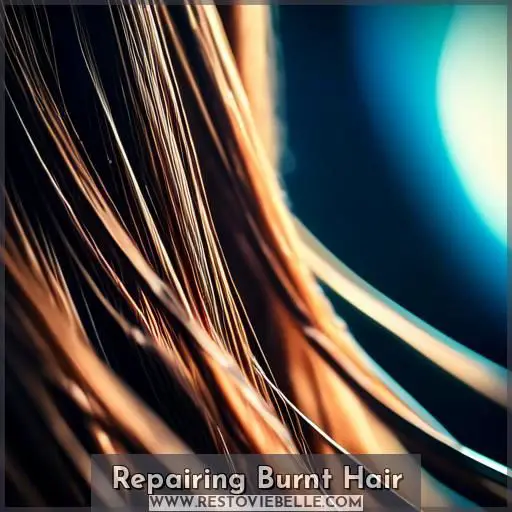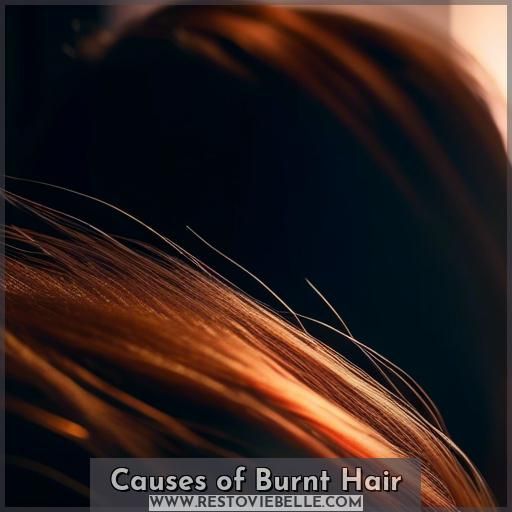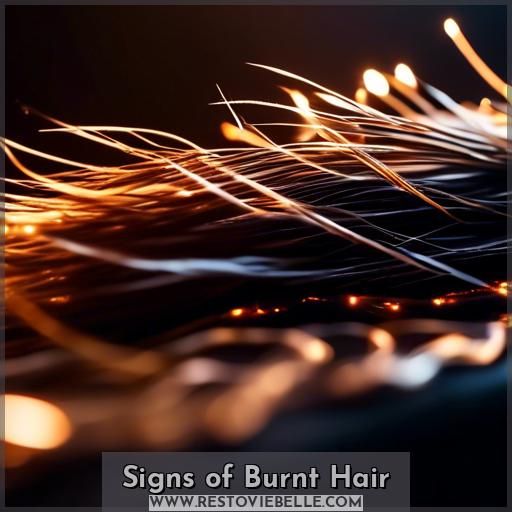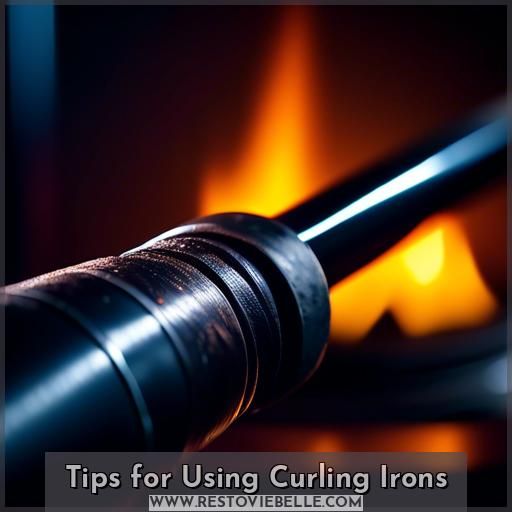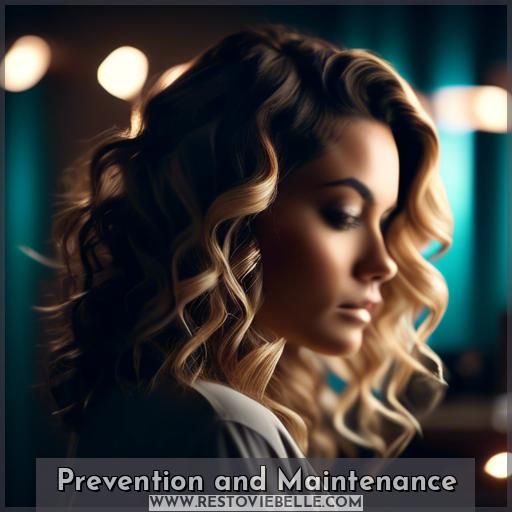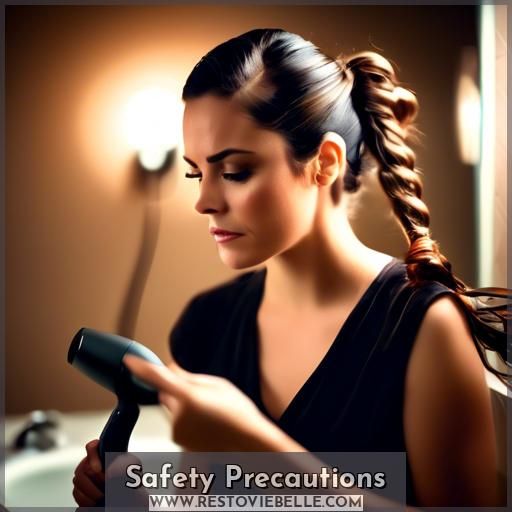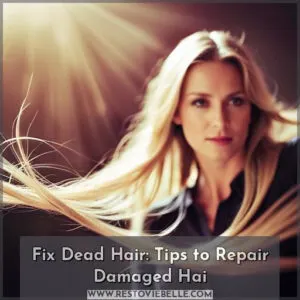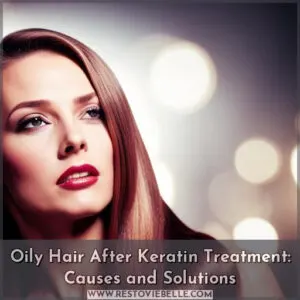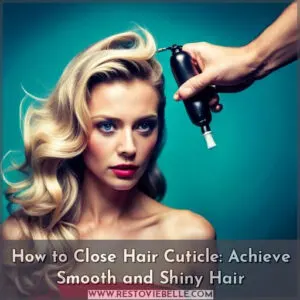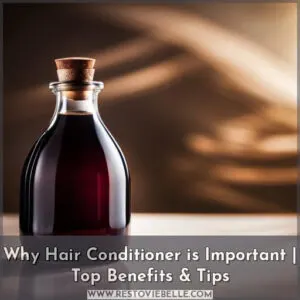This site is supported by our readers. We may earn a commission, at no cost to you, if you purchase through links.
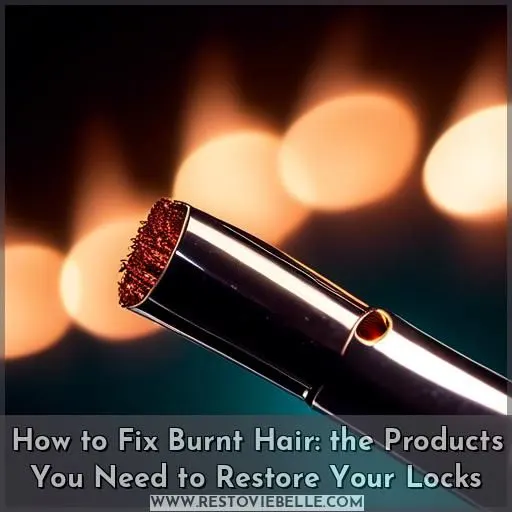
To fix burnt hair from your curling iron, you’ll need to take immediate action.
First, avoid further heat exposure and use a gentle, sulfate-free shampoo.
Next, apply a deep conditioning treatment and follow with a leave-in conditioner containing protective ingredients.
Air-dry or use a low heat setting.
In the long run, get regular trims to remove damaged ends and use a heat protectant spray before styling.
Protein and bond-building treatments like Olaplex can help repair and strengthen your locks.
With the right approach, you can revive your hair and prevent future damage from curling iron mishaps.
But that’s just the start – let’s explore more solutions to restore your tresses.
Table Of Contents
Key Takeaways
- Avoid further heat exposure and cleanse with a gentle, sulfate-free shampoo to start the recovery process for burnt hair.
- Apply a deep conditioning treatment and a leave-in conditioner with protective ingredients to nourish and protect the hair.
- Regular trims are crucial to remove damaged ends, and using a heat protectant spray before styling can help prevent future damage.
- Consider using protein treatments, keratin treatments, bond-building treatments like Olaplex, and ensuring your styling tools have intelligent heat control to repair and strengthen hair.
Immediate Care for Burnt Hair
To care for burnt hair, immediately stop using heat styling tools and apply a gentle, sulfate-free shampoo to cleanse the hair. Follow this with a deep conditioning treatment to nourish the hair and promote healing. A leave-in conditioner with protective ingredients can also help to hydrate the hair and protect it from further damage.
Air-dry the hair or use a low heat setting on your styling tool to minimize further damage.
Avoid Further Heat Exposure
After a hair mishap, it’s imperative to press the pause button on heat styling. Envision your locks as a fragile fabric that requires gentle care.
Replace the hot tools with heat-resistant gloves, and allow your hair to relax on a heat-resistant mat. Embrace the air-dry routine, shielding your strands with a heat protectant to revitalize your damaged hair back to health.
Use a Gentle, Sulfate-free Shampoo
After dodging further heat havoc, it’s time to lather up smartly. Opt for sulfate-free shampoos that promise gentle cleansing without stripping your locks of their much-needed moisture. These hair heroes are packed with nourishing ingredients, setting the stage for damage recovery. Think of it as giving your burnt hair a soothing spa day, minus the cucumber slices.
Apply a Deep Conditioning Treatment
Regarding the repair of damaged hair, the initial action is to provide your hair with essential care. A highly effective method to achieve this is through the application of a deep conditioning treatment. This will contribute to the nourishment and restoration of your hair, providing it with the fortitude required to recover from the harm.
Various treatment options are accessible, both commercially available and homemade. For immediate results, consider using a product such as Oribe Split End Seal or Redken Acidic Bonding Concentrate Leave-In Treatment. These products are formulated specifically to address split ends and repair damage.
Alternatively, if you prefer a more natural approach, you can create your own deep conditioning treatment at home. One option involves combining coconut oil, mayonnaise, and yogurt. Apply this mixture to your hair and allow it to remain for approximately 50-60 minutes before rinsing it out with shampoo. This will assist in restoring moisture and protein to your hair, enhancing its strength and resilience.
Use a Leave-in Conditioner With Protective Ingredients
To revitalize your damaged hair, employing a leave-in conditioner infused with protective ingredients is imperative. These conditioners are formulated to trap moisture and shield your hair from additional harm. They can be particularly advantageous for curly hair, which is prone to dehydration and unruliness.
Seek leave-in conditioners that contain ingredients such as shea butter, argan oil, and jojoba oil, which are renowned for their ability to hydrate and rejuvenate the hair. Some well-received choices include EDEN BodyWorks Coconut Shea Curl Defining Creme, tgin Green Tea Super Moist Leave In Conditioner, and African Pride Moisture Miracle Coconut Milk & Honey Leave-In Conditioner.
Remember to select a conditioner that lists water as its primary ingredient to guarantee that it penetrates the hair shaft for maximum hydration.
Air-dry or Use a Low Heat Setting
Regarding the repair of heat-damaged hair from a curling iron, air-drying or employing a reduced heat setting is paramount. Here is a step-by-step guide to assist you:
- Air-dry: Abstain from heat exposure and allow your hair to air-dry to minimize additional damage.
- Low Heat Setting: Should heat become necessary, select a low heat setting on your styling tools.
- Heat Protectant: Utilize a heat protectant to shield your hair from thermal damage.
- Styling Products: Employ nourishing styling products to foster hair health and rectify the consequences of curling iron mishaps.
Long-Term Care for Burnt Hair
To maintain the health of your hair after a burn, it’s essential to get regular trims to remove damaged ends. Shield your strands before styling with a heat protectant spray, reduce chemical treatments, and refrain from excessive brushing to prevent further damage.
Regular Trims to Remove Damaged Ends
Regular trims are essential for maintaining healthy hair, especially after damage. The frequency of trims depends on your hair type and condition. Your stylist can help determine the best timing for your hair. Remember, damaged ends won’t grow back, so eliminating them is critical for preventing further damage.
Use Heat Protectant Spray Before Styling
Before you crank up the heat, let’s talk defense. A good heat protectant is your hair’s best buddy, acting as a shield against styling scorches. Whether it’s a spray, serum, or leave-in, finding the best heat protectant means checking the ingredients list for hair heroes. Don’t just play with fire; arm yourself with protection that keeps your locks looking lush.
Limit Chemical Treatments
To limit chemical treatments on burnt hair, you should avoid using hair dye, bleach, and hair color. These treatments can further damage your hair, especially if it’s already burnt. Additionally, be cautious with hair extensions, as they can also cause damage. Instead, focus on gentle treatments and products formulated for damaged hair. Remember, patience is key in the healing process.
Avoid Over-brushing
To avoid over-brushing your burnt hair, focus on brushing gently and minimizing brushing altogether. When detangling, be careful not to create unnecessary friction. Use a wide-tooth comb instead of a regular brush to reduce damage. Remember, patience is key in the healing process.
Repairing Burnt Hair
To repair burnt hair, you can use protein treatments to fortify your hair, keratin treatments to smoothen and restore, bond-building treatments to revitalize bonds, and Olaplex treatments to repair broken bonds. These treatments can help restore the health and exuberance of your hair, even after it has been damaged by heat styling tools or other factors.
Protein Treatments to Strengthen Hair
After nurturing your locks with regular trims and protective care, it’s time to beef up your hair’s resilience. Protein treatments are your hair’s gym membership, rebuilding the strength of damaged strands. Think of them as a repair squad, targeting the weak spots and fortifying your hair’s structure. They’re a go-to option for turning brittle into brawny.
Keratin Treatments to Smooth and Repair
After bolstering your hair with protein treatments, it’s time to smooth things over with keratin treatments. These aren’t just any hair smoothing sorcery; they’re your ticket to hair restoration.
- Keratin treatments fill the gaps, literally bringing back the smooth criminal your hair once was.
- They’re the unsung heroes in the realm of chemical straightening and smoothening treatments.
- Think of them as your hair’s personal bodyguard against future assaults.
- Embrace the transformation; your locks will thank you by shining brighter than ever.
Bond-building Treatments to Restore Bonds
Bond-building treatments are designed to repair damaged hair by restoring the bonds that hold the protein chains together. These treatments target the three types of hair bonds: hydrogen, ionic, and disulfide bonds. Hydrogen bonds are the weakest and can be broken by exposure to water and heat, while ionic bonds are broken by water and alkaline substances in chemical treatments. Disulfide bonds are the strongest and are broken by extreme heat and chemical treatments.
To restore the bonds in your hair, you can use products that contain added proteins and amino acids, which help re-form the hair structure with temporary strength and elasticity. Some popular bond-building treatments include Olaplex No. 3 and the K18 Leave-In Molecular Repair Mask, which address broken disulfide bonds. These treatments can help improve the health and appearance of your hair by adding moisture and hydration, and they can be used on all hair types, not just those with damaged hair.
To get optimal results from bond-building treatments, it’s crucial to adhere to the instructions provided by the manufacturer and to use them in conjunction with other hair care products, such as heat protectants and deep conditioning treatments. With consistent use, these treatments can help enhance the overall health and appearance of your hair, making it look shinier, silkier, and stronger.
Olaplex Treatments to Repair Broken Bonds
Olaplex treatments are a game-changer for repairing burnt hair. They work by repairing broken bonds in your hair, which are often the result of heat styling or chemical treatments. These treatments can help restore the strength and elasticity of your hair, making it look and feel healthier.
To use Olaplex, simply apply the treatment to damp hair, leave it on for a few minutes, and then rinse it out. You can also use Olaplex as a pre-shampoo treatment or add it to your conditioner for an extra boost of repair.
With regular use, you’ll notice a significant improvement in the health and appearance of your hair.
Prevention
To prevent burnt hair from curling irons, you should use an innovative tool with intelligent heat control, never skimp on a heat protectant, and keep your hot tool under 350 degrees Fahrenheit. These steps will help guarantee your hair remains healthy and damage-free.
Use an Innovative Tool With Intelligent Heat Control
To prevent heat damage and shield your hair, it’s essential to employ an innovative tool with intelligent heat control. Consider styling tools with advanced heat settings, automatic shut-off mechanisms, and integrated heat protectants. These tools can aid in guaranteeing that your hair isn’t subjected to excessive heat, mitigating the likelihood of burnt hair and damage.
Never Skimp on a Heat Protectant
Switching from innovative tools to the heart of prevention, never skimp on a heat protectant. It’s your hair’s knight in shining armor. Here’s why:
- Types Matter: Choose from sprays, creams, or serums based on your hair’s needs.
- Application Is Key: Evenly coat damp or dry hair before styling.
- Frequency Is Everything: Apply every time you style to shield against heat damage.
Keep Your Hot Tool Under 350 Degrees Fahrenheit
To guarantee your hot tool is harmless for your hair, maintain it below 350 degrees Fahrenheit. Temperature safety is essential for hair preservation.
Employ a device with intelligent heat regulation and retain suitable tool selection. Periodically cleanse your curling iron to thwart accumulation and refrain from using it on damp hair.
By adhering to these directives, you’ll be capable of using your hot tool efficiently and safeguard your hair from harm.
Causes of Burnt Hair
You’ve noticed your hair’s become dry and brittle, a sign you might be overdoing it with heat styling tools or chemical treatments. To prevent further damage, it’s critical to understand the causes, from excessive sun exposure to the friction of tight hairstyles, and take corrective action.
Overuse of Heat Styling Tools
Overuse of heat styling tools can lead to heat damage, moisture loss, hair breakage, strand thinning, and scalp irritation. To prevent heat damage:
Use an innovative tool with intelligent heat control. Never skimp on a heat protectant. Be mindful of the heat setting on your hot tools. Avoid keeping the hot tool on your hair for longer than 10 seconds and keep your hot tool under 350 degrees Fahrenheit.
Chemical Treatments (bleach, Hair Dye)
If you’ve experienced chemical damage to your hair, you’re not alone. Chemical treatments like bleach and hair dye can weaken the hair’s natural structure, making it more prone to breakage. Here are some tips to help you repair and prevent further damage:
- Choose the right products: Look for shampoos and conditioners that are sulfate-free and enriched with nourishing ingredients. Avoid products containing parabens, sulfates, phthalates, and dyes, as they can affect hormonal balance and contribute to hair loss.
- Deep condition: Apply a deep conditioning mask to your hair regularly to provide protein and moisture.
- Use a leave-in conditioner: For added hydration, use a leave-in conditioner that shields your hair from heat, moisture, and environmental pollutants.
- Protect your hair: Wrap your hair, wear a hat, and avoid exposure to the sun, as you’d with a chemical peel on your face.
- Regular trims: Get regular trims to remove damaged ends and encourage healthy hair growth.
- Heat protection: Always use a heat protectant spray before styling to minimize damage from hot tools.
- Limit chemical treatments: Be mindful of the frequency and type of chemical treatments you undergo, as they can weaken your hair over time.
Sun Exposure
Sun damage can be a major cause of burnt hair. To protect your hair from the sun, it’s essential to use sunscreens specifically designed for hair. These products contain UV protection to shield your hair from the sun’s harmful rays. Additionally, wearing a sun hat can provide an extra layer of protection.
Prevention is key in regard to sun exposure and hair damage.
Chlorine Exposure
Chlorine isn’t just a pool’s best friend; it’s your hair’s frenemy. This chemical can lead to chlorine damage, stripping your locks of their natural oils and leaving them dry and brittle. But don’t fret, there’s hope:
- Rinse hair immediately after swimming to minimize chlorine buildup.
- Use a chlorine protection shampoo.
- Apply a chlorine conditioner regularly.
- Consider a weekly deep conditioning treatment.
- Wear a swim cap to shield your hair.
Friction From Tight Hairstyles
Friction from tight hairstyles can cause burnt hair. Avoid tight ponytails, braids that are too tight, and hair rubbing against headbands or scrunchies. Use gentle hair ties and avoid pulling your hair too tightly. A 3×4 table can help you visualize the impact of different hairstyles on your hair health.
Signs of Burnt Hair
If you’ve noticed your hair has a dry, brittle texture, split ends, or a straw-like appearance, these are clear signs of burnt hair. Addressing these symptoms early can help restore your hair’s elasticity and ease detangling.
Dry, Brittle Texture
If you’ve experienced burnt hair, you may notice a dry, brittle texture. This is a sign that your hair needs moisture and elasticity restoration. Use protective products like leave-in treatments and deep conditioning masks to help restore your hair’s health. Remember, patience is key as burnt hair grows back at a rate of about six inches per year.
Split Ends
Split ends are a common sign of burnt hair. To address this issue, consider the following:
- Use a hair mask to nourish your hair and prevent further breakage.
- Opt for hair repair treatments that focus on restoring damaged strands.
- Incorporate a hair growth serum into your routine to promote new hair growth.
- Remember, patience is key when dealing with burnt hair; it will eventually grow back.
Loss of Elasticity
You’re on the right path to understanding the importance of hair elasticity. Elasticity is a measure of your hair’s ability to stretch and return to its original shape without breaking. It’s essential for maintaining the health and strength of your hair. Here are a few key points to keep in mind:
- Hair Elasticity and Porosity: The elasticity of your hair is closely linked to its porosity. Hair with high porosity tends to lose moisture quickly, leading to a reduction in elasticity. On the other hand, hair with low porosity may not absorb moisture as readily, which can also affect elasticity.
- Hair Health and Elasticity: Healthy hair is generally more elastic than damaged hair. When your hair has good elasticity, it’s easier to style and manage, and it looks and feels better. However, if your hair lacks elasticity, it can be prone to breakage and may appear dry or brittle.
- Improving Hair Elasticity: To improve hair elasticity, focus on preserving the health of your hair. This includes using products that safeguard your hair from damage, consuming a balanced diet rich in vitamins and minerals, and limiting excessive heat styling. Regular deep conditioning treatments can also help to improve elasticity by nourishing and strengthening your hair.
- Testing Hair Elasticity: You can test your hair’s elasticity by wetting a strand and gently stretching it between your fingers. If your hair stretches easily without breaking and returns to its original length when released, it has good elasticity. If your hair breaks or doesn’t return to its original length, it may be lacking in elasticity.
Straw-like Appearance
If your hair feels like straw, it’s likely due to a combination of chemical and mechanical damage. Chemical damage can be caused by overprocessing, such as frequent dyeing or bleaching, which can break down the hair’s natural bonds and reduce its ability to retain moisture. Mechanical damage, on the other hand, is caused by rough handling, such as aggressive detangling or excessive brushing, which can lead to split ends and breakage.
To address this issue, it’s imperative to focus on both repairing the damage and preventing further harm. For repair, consider using protein treatments to strengthen the hair, keratin treatments to smooth and repair, and bond-building treatments to restore broken bonds. In the long run, regular trims to remove damaged ends, using heat protectant spray before styling, and avoiding over-brushing can help maintain your hair’s health.
When it comes to prevention, using an innovative tool with intelligent heat control, never skimping on a heat protectant, and being mindful of the heat setting on your hot tools are vital. Additionally, avoid using your hot tool on wet hair and regularly clean your curling iron to prevent buildup.
Difficulty Detangling
After addressing the straw-like appearance, let’s delve into the tangled web your hair has become. Detangling products are your valiant defenders, cutting through knots without inducing hair breakage or shedding. Exercise caution, however, to prevent scalp discomfort.
Bear in mind that split ends are the adversaries of smooth combing. With the appropriate tools, you’ll transform this hair-raising experience into a happily-ever-after tale.
Tips for Using Curling Irons
To fix burnt hair from a curling iron, follow these tips:
- Use a heat protectant spray before styling.
- Choose the correct barrel size for your hair type.
- Avoid curling for too long.
- Use a low heat setting for fine hair.
By implementing these tips, you can minimize the risk of burning your hair and maintain healthy, beautiful locks.
Use a Heat Protectant Spray Before Styling
Before you even think of turning on that curling iron, grab a heat protectant spray. It’s your hair’s knight in shining armor, shielding it from the dragon’s breath of heat. Whether it’s a spray, serum, or cream, applying a heat protectant is a no-brainer for keeping your locks luscious.
Brands vary, but the effectiveness? Always spot-on. Remember, a little goes a long way!
Use the Correct Barrel Size for Your Hair Type
To achieve optimal results with your curling iron, select the appropriate barrel size for your hair type. For thick hair, a wider barrel diameter is recommended. Fine hair requires a narrower barrel diameter to prevent excessive curling. Short hair can benefit from a medium barrel diameter. Always adjust the barrel size according to your hair texture to guarantee a flawless curl.
Avoid Curling for Too Long
To avoid excessive curling and prevent thermal damage, adhere to these guidelines:
- Set a timer: Prolonged curling can lead to damage. Utilize a timer to guarantee you don’t surpass 10 seconds per section.
- Utilize a thermal protectant: Before curling, apply a thermal protectant to shield your hair from excessive heat.
- Select the optimal barrel size: Choose a barrel size compatible with your hair type to minimize damage.
- Refrain from curling damp hair: Allow your hair to dry thoroughly to prevent thermal damage and maintain its health.
- Limit chemical treatments: Excessive use of chemical treatments can weaken your hair, increasing its susceptibility to damage.
Use a Low Heat Setting for Fine Hair
When curling your delicate hair, it’s essential to use a low heat setting to prevent harm. The most suitable temperature for fine hair is below 200 degrees Fahrenheit. Here’s a table to guide you:
| Low Heat Setting | Hair Length |
|---|---|
| 200°F | Fine hair |
| 300°F | Coarse hair |
Using a low heat setting will help you achieve the desired curl without causing heat damage. Remember, fine hair is more fragile and requires gentle care.
Prevention and Maintenance
To prevent burnt hair from using curling irons, it’s imperative to follow specific guidelines:
-
Regularly Clean Your Curling Iron to Prevent Buildup: Clean your curling iron once a week to remove hairspray, leave-in conditioner, and heat protection spray residue. Use a 2-ingredient paste made of hydrogen peroxide and baking powder, or try rubbing alcohol or vinegar for stubborn odors.
-
Avoid Using Your Curling Iron on Wet Hair: Wet hair is more susceptible to damage and burning when exposed to high temperatures. Always start with clean and dry hair before using the curling iron.
By following these precautions, you can minimize the risk of burnt hair and preserve the wellbeing of your hair.
Regularly Clean Your Curling Iron to Prevent Buildup
Regularly cleaning your curling iron is essential to prevent buildup and maintain its performance. Here’s how to do it effectively:
- Cleaning Frequency: Clean your curling iron at least once a week, especially if you use it daily.
- Type of Cleaner: Use a gentle cleaning solution, such as a baking soda paste or a mixture of warm water and dish soap.
- Brush vs. Cloth: A gentle sponge or an old toothbrush can be used for scrubbing, but avoid abrasive materials that may damage the surface.
- Regular Maintenance: Inspect your curling iron regularly for signs of buildup and clean it promptly to prevent damage.
- DIY vs. Professional: While there are DIY cleaning methods, it may be more effective to use professional cleaning products designed specifically for curling irons.
Remember to always unplug your curling iron before cleaning and never submerge it in water.
Avoid Using Your Curling Iron on Wet Hair
When it comes to using a curling iron, it’s key to remember that wet hair isn’t ideal for this heat styling tool. Wet hair is more likely to break and burn when exposed to high temperatures, which can lead to hair damage and even burns. Here’s how to avoid using your curling iron on wet hair:
- Wait for your hair to dry: Always make sure your hair is completely dry before using a curling iron. If you don’t have time to wait for your hair to air dry, you can use a hair dryer to help speed up the process.
- Use a heat protectant: Apply a heat protectant spray or serum to your hair before using the curling iron. This will help protect your hair from heat damage and keep it looking healthy and shiny.
- Choose the right barrel size: Select a curling iron with a barrel size that suits your hair type. For fine or thin hair, opt for a smaller barrel size, while thick or coarse hair may require a larger barrel.
- Avoid overheating: Don’t hold your hair on the curling iron for too long. As a general rule, you can hold it for 5-10 seconds (depending on the thickness of your hair), and then slowly release the hair strand.
- Clean your curling iron: Regularly clean your curling iron to prevent buildup of hair products, which can affect the performance of the wand and cause damage to your hair.
Safety Precautions
To prevent hair damage from a curling iron, it’s crucial to follow safety measures. Always check the manual before using your curling iron, never let it on and unattended, and don’t use it on hair extensions. These precautions can help guarantee your safety and the well-being of your hair.
Always Read the Instructions Before Using Your Curling Iron
Always read the instructions before using your curling iron.
If you connected your curling iron to a 240V connector instead of a 120V step-down converter, the fuse may have blown, and the circuit board could be damaged.
Fuse caps may detach during removal, and a replacement fuse with hooks for attachment is required.
Confirm your understanding of the voltage requirements and consistently adhere to safety precautions to avert further damage.
Do Not Leave Your Curling Iron on and Unattended
Leaving your curling iron on and unattended is like inviting a fox into the henhouse; it’s a recipe for disaster. Here’s how to avoid the burn:
- Heat Damage Prevention: Always use a heat protectant. It’s your hair’s knight in shining armor.
- Avoid Over-styling: Less is more. Give your locks a break.
- Barrel Size Selection: Choose wisely. The right size wards off unnecessary heat exposure and minimizes curling iron damage.
Do Not Use Your Curling Iron on Hair Extensions
Just as you wouldn’t leave a hot iron unattended, don’t tempt fate with your hair extensions. These delicate additions can’t take the heat like your natural locks. Before styling, shield them with a heat protectant to fend off hair damage. Remember, a curling iron is no fairy godmother for extensions; it’s more like a wicked stepmother if used carelessly.
Frequently Asked Questions (FAQs)
How long does it take for burnt hair to grow back?
You’re looking at around 6 months for severely burnt hair to fully grow out from the roots. Just be patient, my friend – that sleek, healthy mane will return before you know it!
What should I do if my curling iron smells burnt?
Let’s imagine you smell that dreaded burnt hair scent from your curling iron. Don’t panic! Unplug it immediately, and give your locks some TLC with a nourishing hair mask. With proper care, your strands will bounce back in no time.
Can I use a hair perfume to cover the burnt smell?
Yes, you can use hair perfume to mask the burnt smell. Opt for ones designed for sensitive scalps or with natural ingredients to avoid irritation. It’s a quick fix to keep you smelling fresh.
Can I use a damaged hair product to repair burnt hair?
Yes, you can use a damaged hair product to repair burnt hair. Products like the Matrix Total Results So Long Damage set, Biolage HydraSource Deep Treatment Pack Multi Use Mask, Kérastase Resistance Masque Extentioniste Mask for Damaged Hair, Redken Extreme Play Safe Heat Protection and Damage Repair Treatment, and L’Oréal Professionnel Steampod Straightener + Curling Iron are specifically designed to address damaged hair and can help repair burnt hair to some extent.
These products typically contain nourishing ingredients like proteins, oils, and moisturizers that can help strengthen, hydrate, and restore the damaged hair cuticle. Using them regularly can help improve the appearance and texture of burnt hair, making it feel softer, smoother, and more manageable.
It’s important to follow the instructions on the product packaging carefully and use them as directed to achieve the best results. Depending on the severity of the damage, it may take several applications or a more intensive treatment regimen to see significant improvements.
How can I prevent burnt hair from chemical treatments?
To prevent burnt hair from chemical treatments, follow these steps:
- Choose the right products: Select shampoos and conditioners specifically designed for chemically treated hair. These products are formulated to protect and nourish your hair, reducing the risk of damage.
- Avoid over-washing: Wash your hair less frequently to preserve its natural oils, which help protect your hair from damage.
- Deep condition regularly: Use a deep conditioning mask for 5-10 minutes after shampooing to provide extra moisture and protection to your hair.
- Protect from the sun: Cover your hair when exposed to the sun, as UV rays can further damage chemically treated hair.
- Schedule regular trims: Get regular haircuts or trims to remove damaged ends and keep your hair healthy.
- Consult a professional: Before undergoing any chemical treatment, have a consultation with a hairdresser to make sure the product is suitable for your hair type and to discuss any potential risks.
- Use heat protectant: If you must use heat styling tools, apply a heat protectant spray before use to minimize damage.
- Be gentle: Handle your hair gently to avoid causing further damage.
Conclusion
Annually, over $1 billion is spent on hair damage repair products.
You’ve learned practical solutions to fix burnt hair from curling iron mishaps.
Follow a routine with gentle cleansers, protein treatments, and heat protectants.
Trim split ends regularly.
Use innovative tools with intelligent heat control, and exercise caution when styling.
With diligence, you can restore your locks’ health and prevent future heat damage.

